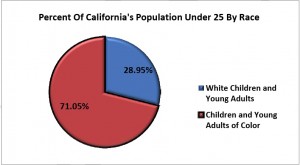The chairman of the Assembly Select Committee on Boys and Men of Color is confident that the bulk of legislation supported by the panel this session will become law. Oakland Democrat Sandré Swanson wrapped up the committee’s first two years yesterday, presiding over a hearing in the Capitol that laid out current and future proposals for creating a path to success for African American, Latino, and Native American boys.

Percent of California’s population under 25 by race. Source: Select Committee report. (Click to enlarge).
Of about 19 bills supported by or introduced by members of the Select Committee, Swanson told EdSource Today he expects as many as 14 will make it to Gov. Brown’s desk (click here for bill info). More than half of those address the disproportionately harsh discipline meted out to black and Latino boys. Recent studies found that although African American boys make up just 8 percent of the state’s public school students, they account for 19 percent of all suspensions. Most of the offenses have nothing to do with violence or bringing weapons to campus; according to the committee’s draft action plan, the transgressions are more than likely to fall into the “willful defiance” category, which includes rude behavior such as talking back to a teacher.
Several other bills, including two by Swanson, are aimed at removing some of the barriers that keep young men who’ve served time in prison from getting the basic support they need to stay out of trouble. One of those, AB 828, would eliminate the ban that prevents some people convicted of drug felonies from applying for food stamps. He’s been trying to get it passed for six years and it’s been slow going this time around.
“If I could get it out of Appropriations and get that bill approved by the Senate and on the governor’s desk, that would be one that would make me very happy because those food stamp services can be added to other community services and then, I think, would lower recidivism,” explained Swanson.
Wednesday’s hearing also raised ideas for legislation that the assemblyman would like to see introduced next year. He was especially moved by testimony from a young man named Michael, who told the committee that as an ex-con he couldn’t get hired anywhere because there’s a box on job applications asking if you’ve even been convicted of a felony. Once, in desperation, he left it blank and got the job, but was fired when the truth came out.
“You would have to think that a solution for this young man who, he said, has not re-offended in three years, could be the simple removal of that declaration,” Swanson said. “We have to examine those questions, and we have to decide if he served his time and paid his dues for the mistake he made, should he have the opportunity to be a productive citizen?”
Convincing Colleagues
Of course, Swanson is well aware that nothing is ever as simple as it seems or ought to be. A draft policy report from the committee describes nearly 60 recommendations for improving opportunities for these young men and boys in the areas of education, health, employment and wealth, juvenile justice and safety, and youth development and policy. Many of the proposals have been circulating for several years:
- Boost efforts to recruit and retain experienced and effective teachers in the state’s highest poverty schools;
- Support innovative programs that link career-themed programs with the new Common Core standards;
- Replace California’s byzantine school funding method with a weighted student funding formula that provides additional funds to schools with large numbers of English learners and students living in poverty; and
- Continue developing CALPADS, California’s longitudinal student data system, which when fully operational will provide a trove of information on what teaching methods and programs improve learning for different students.
That the recommendations have widespread support was clear from the testimony of state officials at yesterday’s hearing, said Jorge Ruiz de Velasco, director of education at Berkeley School of Law’s Chief Justice Earl Warren Institute on Law and Social Policy. From State Attorney General Kamala Harris, who made an unexpected visit to the hearing, to representatives from the State Departments of Education, Labor, and Human Services, no one criticized or quibbled over the policy recommendations.
“Not a single one of them came and said, “Oh, you’re on the wrong track, or, this is not important, or we disagree with recommendation 5.6.’ All of them pretty much fully embraced it and would add to it,” said Ruiz de Velasco, who co-wrote the report.
Getting legislators to show the same enthusiasm is a harder sell, but Swanson argues that investing money will save money. According to the
Educational disparities for boys by race. Source: RAND Corp. (Click to enlarge.)
California Dropout Research Project at UC Santa Barbara, funding programs that increase the state’s graduation rate for African American and Latino boys by 10 percent would generate more than $7 billion in additional income, tax revenue, and economic productivity for the state over their lifetimes.
Doing nothing is expensive. The status quo, according to the draft policy report, is a prison system where the cost of sending young men and boys of color to juvenile hall, jail, and prison “far exceeds the costs of sending them to the most expensive private universities in the world.”
Over the next 30 days, the draft recommendations will be open for comment and the Select Committee will vote on the final report and send it to the Legislature. By then, it will be the end of September, the current session will be over, and Assemblyman Swanson will be termed out of office. Before leaving, he has one final recommendation to Assembly Speaker John Pérez: appoint a new leader and continue the Select Committee on the Status of Boys and Men of Color.
To get more reports like this one, click here to sign up for EdSource’s no-cost daily email on latest developments in education.